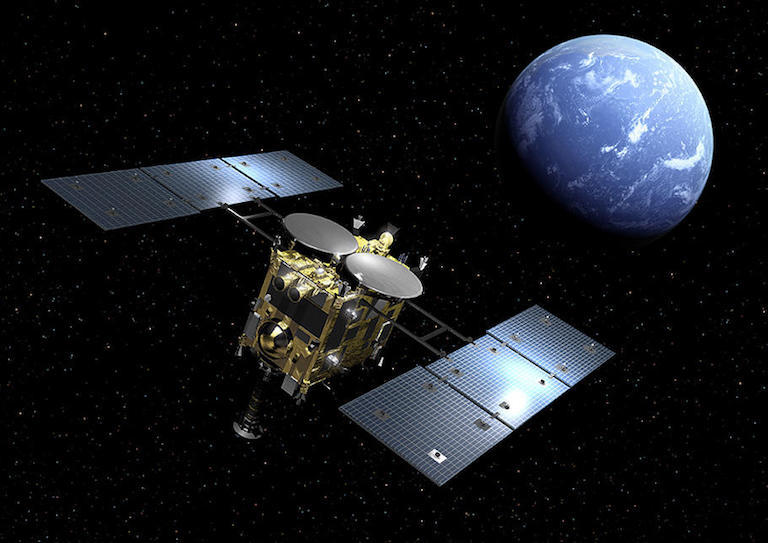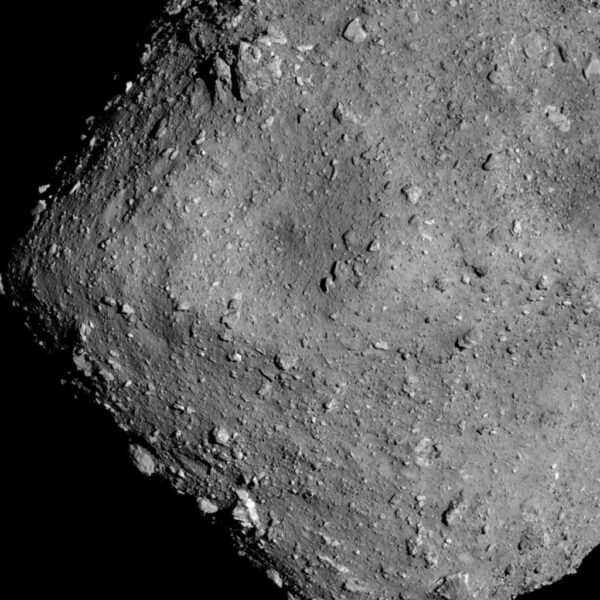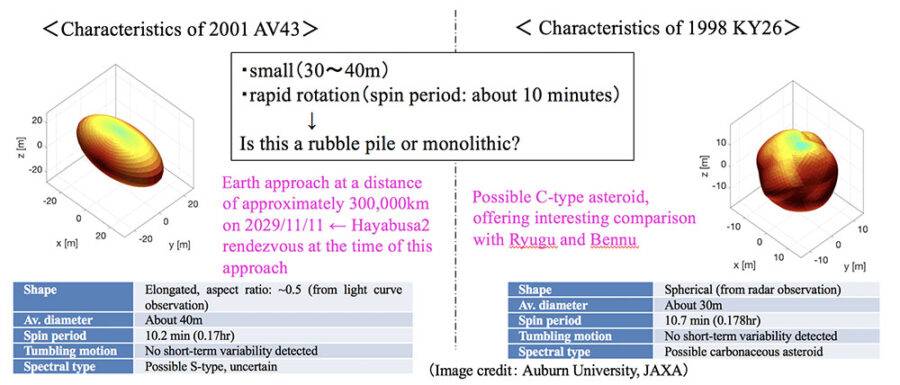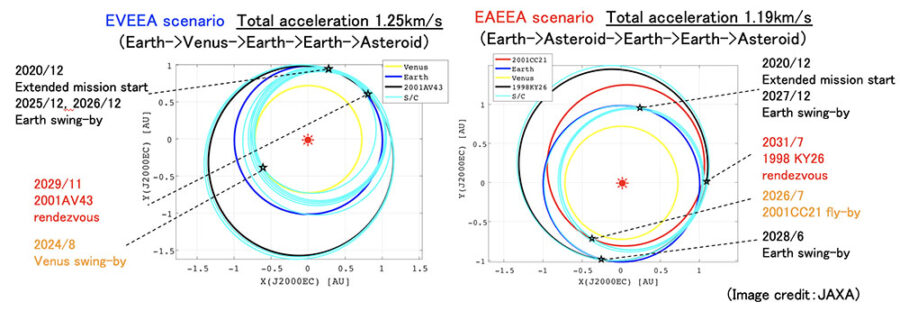The Hayabusa 2 team has laid out a proposal for an extended mission to one of two asteroids after the spacecraft’s sample return this December.

JAXA
Where should Hayabusa 2 go next? It’s a long road from mission proposal to design, construction, launch, and arrival. Once you’ve got a perfectly functioning platform in space, it only makes sense to squeeze as much science out of it as possible.
That’s just what the Japan Aerospace Exploration Agency (JAXA) hinted at in a tweet last month for the Hayabusa 2 mission. Launched in December 2014 from the Tanegashima Space Center in Japan, Hayabusa 2 flew past Earth for a gravitational assist on December 3, 2015, arrived at asteroid 162173 Ryugu, sampled the 0.6-mile (1-kilometer) wide space rock, dropped off some asteroid rovers, and departed on November 12, 2019 to head back toward Earth by the end of the year.
The spacecraft will drop off its sample return capsule during an Earth flyby on December 6, 2020. The 16-kilogram (35-pound) sample return capsule is due to reenter over the Woomera Test Range in the Australian Outback with its precious pieces of Ryugu.
But once the flyby and sample drop-off are complete, the spacecraft will still have half of its xenon thruster fuel remaining. The spacecraft is in good shape, so JAXA engineers are now looking at the possibility of sending the mission on to a second or even third asteroid target.

JAXA
Narrowing Down the Field
The possible secondary targets include the oblong asteroid 2001 AV43 or the asteroid 1998 KY 26. They're each about the size of a large house and both orbit the Sun in roughly 500 days. The proposed plan would see Hayabusa 2 arriving at 2001 AV43 in the late 2029 time frame, or reaching 1998 KY26 in July 2031. Both asteroids have a low enough relative speed relative to the spacecraft to put them within (eventual) reach after Hayabusa 2's December flyby.

JAXA / Auburn University
Interestingly, 2001 AV43 will fly 313,000 km from Earth (0.8 times the Earth-Moon distance) on November 11, 2029.

JAXA
The two asteroids were selected from an initial field of 354 candidates, which was winnowed down based on accessibility and scientific interest. Both are fast rotators, as evidenced by their light curves, each spinning on its respective axis once every 10 minutes. This represents the shortest "day" of any known object in the solar system, suggesting that these asteroids are in fact solid objects and not simply loosely aggregated "rubble piles." A visit to one of these asteroids would mark the first time a space mission has seen such an enigmatic fast rotator up close.
The asteroid 1998 KY26 is also a possible carbonaceous (C-type) asteroid, and Hayabusa 2's exploration of such a space rock would be another first.
Now, JAXA engineers and scientists must select between the two possible targets. Reaching 2001 AV43 would involve a Venus flyby and several additional Earth swing-bys to put the spacecraft on the right track, while approaching 1998 KY26 would involve Earth flybys and a possible distant pass by asteroid 2001 CC21 in 2026.

NASA
If JAXA opts for the Venus flyby and heads for 2001 AV43, the space agency could use observations carried out by Hayabusa 2 to complement its Akatsuki mission, currently in orbit around the second planet from the Sun.
Finally, JAXA has to secure the funding for such a long (decade-plus) mission extension. In addition to proving the technical ability of complicated deep-space navigation, visiting an additional asteroid gives Japan an opportunity to test protective maneuvers, in case we ever need to move an asteroid out of Earth's way.
JAXA’s definitely getting their money’s worth out of Hayabusa 2, as the mission heads for home and beyond.
 3
3









Comments
Anthony Barreiro
August 8, 2020 at 3:41 pm
The third sentence in the first paragraph of the "Narrowing Down the Field" section reads: "The proposed plan would see Hayabusa 2 arriving at 2001 AV43 in the late 2029 time frame, or reaching 2001 AV 43 in July 2031." From the figure below that paragraph, it looks like Hayabusa 2 would reach 1998 KY 26 in July 2031.
You must be logged in to post a comment.
Anthony Barreiro
August 10, 2020 at 6:51 pm
Thanks, editor!
You must be logged in to post a comment.
Thomas Aquinas
August 21, 2020 at 2:54 am
I understand with the world as it is why the public doesn't rally to the deep space missions. They should know that with the new probes, we aren't just flinging spacecraft on one way ballistic arcs thru the solar system but are actually travelling from body to body, actually in the science of space-faring. This is a huge step as we explore minor planets, etc. In fact, one day our planet might depend on this, if heaven forbid an object was calculated to come too close to the earth-moon planetary system.
You must be logged in to post a comment.
You must be logged in to post a comment.